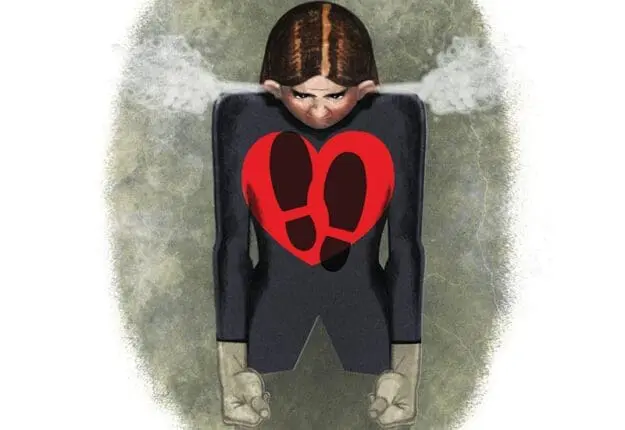Intimate betrayal strikes at the core of our capacity to trust and love, violating the fundamental expectation that gives us the courage to connect deeply—the belief that the person we love won’t intentionally hurt us. Whether the betrayal is through infidelity, emotional abuse, verbal aggression, or domestic violence, the psychological wound that cuts deepest is the perception that, ultimately, the person we love doesn’t care about our well-being. When humans feel betrayed, we tend to withdraw from contact or furiously lash out in distress, just as do other mammals suffering intense pain.
Cases of intimate betrayal require therapists to reach a balance between validating their clients’ pain and empowering them to improve their lives. If you don’t validate their experience enough, betrayed clients will resist your best therapeutic efforts, feeling you don’t understand their pain. However, if you validate their emotional suffering too much, they may get stuck in their intense and immediate pain. They may even feel that moving on in their lives means losing their identities, since many of them can’t imagine themselves as anything except depressed, anxious victims.
Finding this particular balance was my challenge with Debbie, who’d been married for more than 13 years to a resentful, highly critical man, who’d recently taken most of their retirement savings and left her for a younger woman. Seven months after her divorce was final, Debbie came to see me following an incident in which she’d burst into angry tears after a harried grocery checker had sighed at her for swiping her debit card backwards. Her instantaneous expression of remorse and embarrassment had only made the situation more awkward for her, the cashier, and the shoppers in line behind her.
This dramatic overreaction was one of many such incidents that had plagued Debbie since her divorce. Her previous therapist had tried to help her by exploring her emotions around her husband’s multiple betrayals and linking her anger, resentment, shame, and feelings of abandonment to childhood events. But her flare-ups over everyday occurrences had only increased. Finally, the therapist suggested she use medications, which she refused to do.
Taking a different tack, I assured Debbie that her feelings and reactions were normal—a natural response when a heart is scraped raw by a devastating betrayal. Rather than delving into her childhood, I proposed that we work on increasing her sense of self-worth while teaching her to embrace her deepest values. Through the process of becoming the person she wished to be, I said, she’d learn how to disarm her hair-trigger defense system.
Establishing a Healing Identity
The first therapeutic challenge with Debbie was to help her overcome her victim identity. Like so many who’ve suffered intimate betrayal, she’d come to identify with the bad treatment she’d suffered and all the defects and weaknesses she saw in herself as a result of it. To establish an alternate, healing identity—one that tapped into her resilience, deep values, and desire to improve her life—we began with an inventory of her strengths, which she decided were intelligence, curiosity, resourcefulness, adaptability, and integrity. Then we explored her deeper values, which she said were honesty, responsibility, spirituality, fairness, compassion, love, and appreciation of nature. When we sought out evidence of her resilience, she remembered a time several years before, when she’d recovered from a serious illness while dealing with the loss of her closest friend from breast cancer.
As this healing identity came into focus, Debbie could see clearly that she’d become bitter, anxious, and irritable during her marriage, not the kind of person she wanted to be. It isn’t unusual for people to cope by mirroring the unwanted behaviors of those who’ve betrayed them. To combat this tendency and remind clients of who they want to be, I ask them to write a letter to themselves, stating how they’ll behave differently from their betrayers. Debbie wrote, “He lied all the time; I’ll be truthful in all my relationships. He cheated on me; I’ll be loyal and sensitive to the well-being of those I love. He abused me; I’ll be compassionate to those I love. He was manipulative; I’ll be kind and supportive to those I love. He criticized me for reading too much; I’ll enjoy learning.”
Soon after writing her letter, Debbie decided to pursue a forgotten dream of launching an online macramé outlet, and she set a goal of volunteering at an animal-rescue operation once a month, which she’d enjoyed doing before her husband had ridiculed the activity as a “waste of time.”
Reconditioning the Mind
Emotional healing happens when the brain associates painful images of injury or damage with restorative images of personal symbolic significance. Restorative images motivate behavior that encourages growth and enhances a sense of safety and well-being. For most people, this process occurs naturally over time, as is evident in the normal grieving process following the death of a loved one. In the beginning, memories of the deceased amplify the sense of loss and inhibit emotional investment in others; over time, however, the focus shifts from what’s been lost to what’s been gained from knowing the loved one. This shift allows positive memories, or restorative images, of the deceased to dominate the mind.
To move on from her negative memory loops, Debbie made a list of all the multiple betrayals in her marriage, and then she chose restorative images—such as holding both her children when they were babies, her favorite necklace made by a close friend, and helping her arthritic neighbor weed his garden—to counteract each negative item on her list. To begin the reconditioning process, she put aside 15 minutes every day to go over her practice of pairing restorative images with each painful memory on the list. For most people, this activity becomes easier after a few days, but Debbie was still having difficulty after several weeks. So she tripled her list of restorative images and increased her practice sessions to seven times a day, repeating the associations for as long as it took to feel calm—usually around 10 to 12 minutes. Within six weeks, as she succeeded in training her mind to invoke her restorative images automatically, the intrusive images of betrayal waned in frequency and intensity. For the first time in her life, she felt as though she could control her thoughts and feelings.
Guilt and Shame vs. Compassion
In the aftermath of intimate betrayal, people often experience deep guilt and shame, but the key to healing is for clients to develop self-compassion and an understanding that their worth isn’t a reflection of how they’ve been treated. Instead, their self-value is ultimately connected to their deeper values and feeling of compassion for others.
To help Debbie find an alternative to the negative emotional states that dominated her life, I asked her to list the things causing her to feel guilt or shame and then to explore possible ways of expressing self-compassion and compassion for others. The following example of the process is one of several she came up with.
- Guilt/shame: I lied to my family about the abuse I suffered all through my marriage, falsely assuring them that things were fine.
- Self-compassion: I was so ashamed that I couldn’t face the truth myself. I’ll embrace the power of truth in the future, because I’m a truthful person.
- Compassion for others: I’ll assure my loved ones that they deserve the chance to be compassionate and helpful to me. I’ll be honest and open with them.
It took several sessions, with plenty of homework, for Debbie to finalize her lists, but soon she was incorporating what she wrote into her actions on a daily basis. The process of extending compassion to herself and others helped her clarify and embrace her deepest values.
The Ability to Love Again
In the final phase of Debbie’s treatment, the focus changed from developing a healing identity to making new connections, particularly with men. With clients at this stage, I often focus on the distinction between wise trust and its opposites: blind trust and suspiciousness. Wise trust recognizes that we’re all frail creatures capable of betrayal in weaker moments. Blind trust denies this darker characteristic of human nature; suspiciousness exaggerates its presence. Wise trust in action involves a measured assessment and recognition that, despite the alarms triggered by old hurts, the actual probability of betrayal may be quite low if a person has demonstrated trustworthiness over time and under stress.
When Debbie was ready to start dating, we spent time carefully going over the signs of trustworthiness—or a lack of it—in potential partners. We discussed how to determine the likelihood of betrayal by ascertaining how someone responds to feeling vulnerable. When someone responds to a feeling of vulnerability by becoming angry, resentful, or depressed, he or she is likelier to betray you by shutting down, punishing, controlling, or seeking some kind of temporary ego boost through infidelity, impulsive indulgence, or deception. By contrast, someone who responds to feeling vulnerable by trying to improve the situation, connect, or instinctively protect is far less likely to betray you. Eventually, as Debbie began going on dates regularly, I gave her a sheet of paper to fill out to help her assess the probability of future betrayal, asking her to circle all the words that applied. One example from this paper is: “When feeling vulnerable (e.g., anxious, devalued, rejected, powerless, inadequate, unlovable), he tries to improve the situation, connects with me, shuts down emotionally, gets angry, deceives, abuses others, abuses me.”
When Disappointment Feels Like Betrayal
After several months, Debbie began dating a man with whom she felt a strong connection. One day, however, when they were grocery shopping together, he paid too much attention to a young woman in tight shorts in the produce aisle. The fact that he’d failed to “control his eyes” while knowing her sensitivities after her ex-husband’s infidelities seemed like a full-fledged betrayal to Debbie. Since that episode, she’d found herself increasingly irritated and critical with this man when they disagreed about things like politics, books, movies, and other preferences.
I explained to her that after intimate betrayal, it’s easy to misinterpret the anxiety signals that occur with feelings of common disappointment and think that you’re being betrayed once again. To distinguish the difference between disappointment and betrayal for Debbie, I put it this way: “Disappointment is about the way the house looks at a given moment, but betrayal is a gaping crack in the foundation. We can’t assume that displaced furniture signals a crack in the foundation, just as we can’t improve the foundation by rearranging the furniture. Some disappointments can be corrected through negotiation or compromise. Others must be accepted and tolerated if the relationship is otherwise healthy and viable. However, betrayal is nonnegotiable and intolerable, and it should never be accepted without significant relationship repair.”
I went on to offer Debbie a series of specific questions she could ask herself whenever her anxiety was triggered by disappointments in a relationship.
Was the behavior a violation of trust? Debbie’s answer regarding the incident in the grocery store was “Not really, though it seemed so at the time.”
What else might it have been? Debbie replied, “I read that men are more susceptible to visual stimulation, and that sometimes they aren’t immediately aware of where their eyes go. In fact, that’s exactly how my boyfriend described it.”
In the future, what might you say to your boyfriend about how you’d like him to handle similar situations? Debbie said, “I know it’s not that big a deal for you to glance at other women and that sometimes you might not know that you do it, but I’d really appreciate it if you’d be more mindful about it when you’re with me.”
I suspect that Debbie responded well to the approach presented in this case because she was tired of feeling like a victim—a condition that was inadvertently strengthened by her previous therapist, who’d overvalidated her painful experience and tried to relate it to childhood events. In our initial work, although we discussed why her highly emotional reactions were a completely normal response to intimate betrayal, we began to focus on how she could have a greater sense of identity and self-worth by connecting with her deeper values. I began to encourage a sense of empowerment, more so when my efforts to get her to focus on her deeper values and the life she wanted to have in the future had yielded some results. At that stage of therapy, I could point out to her that her straighter posture, more resonant voice, and increased confidence indicated that she was experiencing increased well-being.
Most clients eventually learn the difference between an internal sense of authenticity (who they are at the deepest level) and the self-righteous satisfaction of feeling wronged by the disappointments and abuses they’ve endured. When they experience that tipping point, many are finally ready to do the hard, repetitious work of building new habits of emotional regulation and commit themselves to their deeper values. At that point, they can let go of their sense of victimhood and embrace the rewards—and risks—of living and loving fully as they move forward in their lives.
Case Commentary
By William Doherty
There are a dozen admirable features of Steven Stosny’s work with this client, but I’ll focus on just one here. A key challenge to conventional psychotherapy with clients who’ve been betrayed by a loved one is the risk that we’ll inadvertently encourage them to remain stuck in a victim identity. When we spend session after session on the betrayal experience and related events going back to childhood, we may think we’re helping them work through and transcend their painful experiences, but the reverse may occur: they may come to see themselves as lifelong victims of bad or flawed people, ultimately becoming tragic figures in their own life dramas.
Stosny deftly avoids this risk by taking another path. After the necessary first step of showing deep empathy for Debbie’s feelings of betrayal, he moves quickly to work the resilience side of her experience, her “healing identity.” Although this may seem like conventional psychotherapy (don’t we all work on our clients’ strengths?), he also helps Debbie confront how badly she’s treating other people around her. My therapist colleagues Noel Larson and James Maddock, who’ve worked extensively with trauma, have observed that victim and perpetrator are often paired identities, with the victim identity giving permission to the inner perpetrator to lash out or take advantage of others. Stosny talks about it as mirroring the unwanted behavior of the one who’s hurt us.
In working with Debbie, Stosny demonstrates how we heal ourselves by understanding how we treat other people when we’re in pain, and how self-compassion must be paired with compassionate, fair treatment of others. Therefore, he highlights the importance of helping clients access their core values for how they want to live in the world. Stosny is that rare therapist who talks explicitly about values (dare I say moral values?) and invites clients to live consistently with their deepest values. Since the days of Freud, therapists have been ambivalent about values-talk in therapy, seeing it either as intellectualization not worth exploring, or as something imposed by the superego or society, to be deconstructed.
However, we now know more about how closely interpersonal values and a healthy sense of self are intertwined. Forming healthy personal boundaries—a primary goal for anyone who’s been abused and betrayed—means learning to respect the boundaries of others. In the hands of therapists like Steven Stosny, psychotherapy heals by bringing out the healer in clients.
Illustration © Sally Wern Comport
Steven Stosny
Steven Stosny, Ph.D. is a well-known therapist and author of many books and articles. He’s appeared on all the major networks and national radio shows, most of the major newspapers and magazines. He has taught at the University of Maryland. His blog on PsychologyToday.com has more than 21 million views.
William Doherty
William Doherty, PhD, is emeritus professor of family social science and former director of the Minnesota Couples on the Brink Project at the University of Minnesota. He is cofounder of Braver Angels and author of the book, Becoming a Citizen Therapist (with Tai Mendenhall).














